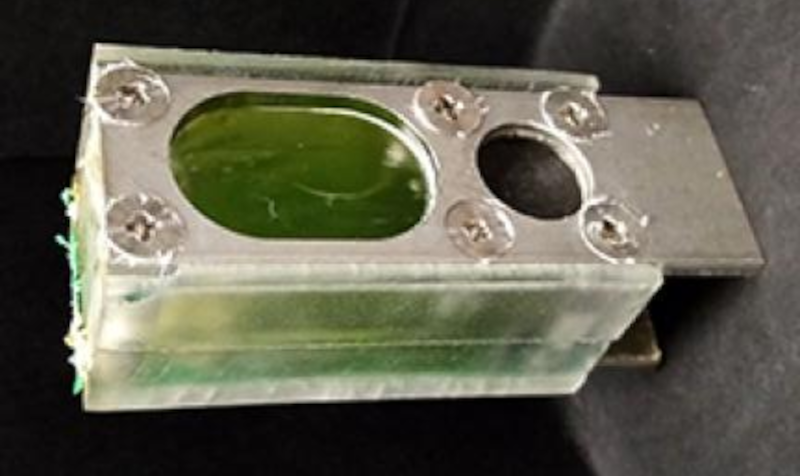What’s the size of an AA battery and can run an ARM Cortex M0+ for six months? Well… probably an AA battery, but obviously, that wouldn’t be worth mentioning. But researchers at Cambridge have built a cell of blue-green algae that can do the job.
As you might expect, the algae need light, since they generate energy through photosynthesis. However, unlike conventional solar cells, the algae continue to produce energy in the dark at least for a while. Presumably, the algae store energy during the day and release it at night to survive naturally-occurring periods of darkness.
Generating power from photosynthesis isn’t a new idea since photosynthesis releases electrons. A typical cell has gold electrodes and a proton exchange membrane of some kind. You can see a video from Cambridge below about generating electricity from photosynthesis. Keep in mind, of course, that the Cortex M0+ is capable of very low power operation. Don’t look for that algae-powered spot welder anytime soon.
People tend to get fixated on electricity as energy, but there are other ways to harness photosynthesis. For example, we’ve seen algae fueling a chicken hole in the past. Not to mention we’ve seen algae used to power a robot in a novel and non-electrical way.
















At the power consumption of this chip an AA battery would certainly power it for a year.
I’ve built Arduino projects (with a Pro Mini) that run for over five years on a single coin cell.
Which is fine, but entirely missing the point.
Most people just want to self-insert their story in other conversations.
@ontopic:
I like this concept, though I still wait for a methane bioreactor to power a fuel cell akin to:
DOI: 10.1038/s41560-018-0262-5
What is the point, then? I think this device is super cool, but I can’t think of a situation where algae would be better than a AA or perhaps a small solar cell. I’ll heavy that the recycling angle is very interesting.
A device that never needs a battery change. Even a solar cell breaks down over time. Algae, being alive, self repair and self regenerate. Worn out organisms die, freeing up resources for younger ones.
Is this still tech site? Where is a single data of power output of the cell? Any EE or editor left in the team?
They chose a microcontroller which consumes 1uW. Assuming a AA battery is 1squareinchn, you’d need about 7000 square feet of these to power your 1w flashlight. There’s not much to see here.
That doesn’t negate it as a potentially very useful powersource for the low draw remote devices – a battery MAY run them for longer, but it will most likely fail out in the wilds before its out of power and costs more to create at least from an environmental damage point of view – if this works as it seems the worst that happens is you flush out and re seed with a tiny volume of algae good to go for ages again.
Doesn’t need to power something big to be useful in the right place. The real question is does it have anything on normal PV solar cells? As if it doesn’t either survive harshes conditions, work better at least in some light levels or work out supremely cheap to manufacture why bother.
Following that DOI https://pubs.rsc.org/en/content/articlelanding/2022/EE/D2EE00233G you are asked for GBP42,5 für that article. Yeah, no. Not on sci-hub yet, unfortunately…
Maybe need to fire up yer CRISPR and splice the genes of those algae into something like https://en.wikipedia.org/wiki/Fenestraria
Then we might be growing self contained solar cells… if we’re really smart maybe find some genes that concentrate metals from the soil and grow the contacts too.
That is a flipping cool plant
Yah, I thought my chain was being yanked when I was looking up plant sources of oxalic acid* and it said those use them for optical fibers, it’s was a real gobsmacker.
*and other organic acids for enhancing electroplating penetration into fine surface detail. That was some rabbit hole.
Be careful with oxalic acid – gloves, safety glasses, proper mask and outside – your kidney will be grateful.
This remindsme of an awesome 20th century book, “Schilfgras statt Atom” (ISBN 3492035795, German, a direct translation could be “reed canary grass instead of atom”).
Astrophage
Thankfully a milligram of algae isn’t likely to blow up with the force of a ton of TNT.
Checked the manuscript and I’m not impressed. The energy this thing creates comes from the dissolution of the aluminium, not the photosynthesis! The photosynthesis just helps in oxidizing the aluminium, you could as well us air and an electrolyte like K2CO3. This thing doesn’t generate power from algae just like a potato doesn’t generate power from potatoes in a potato battery. The whole study was just done (or written up) for hype, it’s certainly not science. What’s the hyothesis? More oxygen make rusting go brr? Well, no surprise. Plus – it has the most atrocious cyclic voltammogram I’ve ever seen in a study.